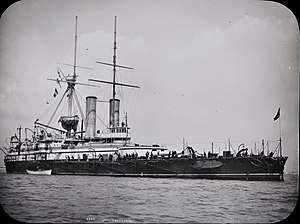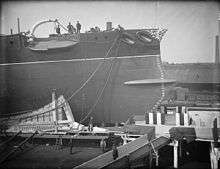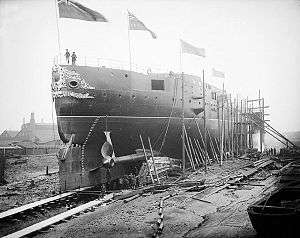HMS Sans Pareil (1887)
HMS Sans Pareil was a Victoria-class battleship of the British Royal Navy of the Victorian era, her only sister ship being HMS Victoria.
 | |
| History | |
|---|---|
| Name: | HMS Sans Pareil |
| Builder: | Thames Ironworks and Shipbuilding Company, Leamouth, London |
| Laid down: | 21 April 1885 |
| Launched: | 9 May 1887 |
| Commissioned: | 8 July 1891 |
| Nickname(s): | Sans Pareil and her sister ship Victoria together were known as "The Pair of Slippers"[1] |
| Fate: | Sold for scrapping to Thos W Ward 9 April 1907 |
| General characteristics [2] | |
| Class and type: | Victoria-class battleship |
| Displacement: | 10,470 tons |
| Length: | 370 ft (110 m) |
| Beam: | 70 ft (21 m) |
| Draught: | 26 ft 9 in (8.15 m) |
| Propulsion: |
|
| Speed: |
|
| Complement: | 550 |
| Armament: |
|
| Armour: |
|
| Service record | |
| Part of: |
|
In deciding upon her design configuration the Board of Admiralty took what history shows was a retrograde step by requesting the reversion from barbettes to turrets for her main armament. She was completed slightly later than her sister-ship and was hence the last British battleship ever to be equipped with her main armament mounted in a single turret.
The choice of calibre, while influenced by the desire to mount as heavy guns as possible, was also influenced by the slow rate of production in the Woolwich yards of the 13.5-inch (340 mm) calibre guns mounted in most of the preceding Admiral class. HMS Benbow, of that class, mounted the heavier calibre guns for the same reason. Following on from this decision, and given that a turret is heavier than a barbette, it was not possible to mount the two guns separately in fore and aft positions and at the same time keep the ship within the displacement stipulated by the Board. Hence both were mounted in a single turret, placed forward of the superstructure. To provide a nominal fire to stern, a 10-inch (250 mm) gun was mounted aft of the superstructure, behind a light armour shield. This weapon fired a shell weighing 500 pounds with a muzzle velocity of 2,040 ft/s (620 m/s), and could in theory penetrate an iron plate of thickness of 20.4 inches (520 mm) at a range of 1,000 yards (910 m).
The Elswick yards also experienced delays in producing the gun of 16.25 inches (413 mm) calibre, so in fact the times between laying down and completion of the Admirals and of Sans Pareil were closely comparable.
Sans Pareil was the last battleship to be designed by Nathaniel Barnaby.
Service history


She was commissioned at Chatham on 8 July 1891 to take part in manoeuvres, and then went into reserve. She was posted to the Mediterranean Fleet in February 1892, serving on this station until April 1895 when she paid off and was named as port guard ship at Sheerness. She was refitted from April 1899, and resumed duty as Sheerness guardship on 19 January 1900,[3] serving until January 1904. On 1 October 1901 Rear-Admiral Sir Baldwin Walker hoisted his flag as second in command of the Reserve squadron.[4]
In June 1902 she was docked in the Medway, during a trial of the New Bermuda Floating dock.[5] She took part in the fleet review held at Spithead on 16 August 1902 for the coronation of King Edward VII,[6] and the following month went to Chatham Dockyard for a short refit,[7] resuming duty after a couple of weeks.
She was sold for scrap in 1907 as part of the fleet modernisation programme instigated by the First Sea Lord, Admiral Fisher.
The ship was sold for scrap, and dismantled at the dock on the River Ribble, Preston, Lancashire. A model of the ship was removed from her at that time and is thought to be either the builder's model or constructed by the ship's crew. Whilst requiring some restoration, this fine model (about 3m long) is on display in 'The Story of Preston' at Preston's Harris Museum and Library.
Captains
- Captain H. C. Bigge - in 1900
- Captain Archibald James Pocklington - 26 February 1901 - ? - as Flag Captain[8]
Notes
- Hough, p. 48
- Chesneau, Koleśnik & Campbell 1979, p. 30.
- "Naval & Military intelligence". The Times (36044). London. 20 January 1900. p. 12.
- "Naval & Military intelligence". The Times (36575). London. 2 October 1901. p. 10.
- "The New Bermuda Floating Dock". The Times (36787). London. 6 June 1902. p. 8.
- "The Coronation - Naval Review". The Times (36845). London. 13 August 1902. p. 4.
- "Naval & Military intelligence". The Times (36861). London. 1 September 1902. p. 8.
- "Naval and Military intelligence". The Times (36384). London. 21 February 1901. p. 10.
References
- Hough, Richard. Admirals in Collision. New York: The Viking Press, 1959. Library of Congress Card Catalog Number 59-13415.
- Oscar Parkes, British Battleships ISBN 0-85052-604-3
- Chesneau, Roger; Koleśnik, Eugène M.; Campbell, N.J.M. (1979). Conway's All the World's Fighting Ships, 1860–1905. London: Conway Maritime Press. ISBN 0-85177-133-5.CS1 maint: ref=harv (link)
| Wikimedia Commons has media related to HMS Sans Pareil (ship, 1891). |